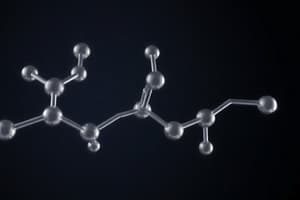Podcast
Questions and Answers
What is the result of a substrate being converted into a product at an accelerated rate in an enzyme reaction?
What is the result of a substrate being converted into a product at an accelerated rate in an enzyme reaction?
- Increased activation energy
- Decreased activation energy (correct)
- Destabilization of the enzyme
- No change in activation energy
Which type of enzyme inhibitors act only on one enzyme or a small group of enzymes?
Which type of enzyme inhibitors act only on one enzyme or a small group of enzymes?
- Irreversible inhibitors
- Non-specific inhibitors
- Reversible inhibitors
- Specific inhibitors (correct)
What is the characteristic of irreversible inhibitors?
What is the characteristic of irreversible inhibitors?
- They bond covalently to a particular group at the enzyme (correct)
- They have no effect on the enzyme's activity
- They cause reversible inactivation of the enzymes
- They act on a wide variety of enzymes
What is the main goal of most drug therapy based on enzyme inhibition?
What is the main goal of most drug therapy based on enzyme inhibition?
Which model describes how an enzyme undergoes a conformational change to optimally interact with the substrate?
Which model describes how an enzyme undergoes a conformational change to optimally interact with the substrate?
Which type of irreversible inhibitor is considered unsuitable for therapeutic purposes?
Which type of irreversible inhibitor is considered unsuitable for therapeutic purposes?
What is the main characteristic that distinguishes competitive inhibitors from noncompetitive inhibitors?
What is the main characteristic that distinguishes competitive inhibitors from noncompetitive inhibitors?
Which type of inhibitor binds to a site away from the active site, causing conformational changes in the enzyme?
Which type of inhibitor binds to a site away from the active site, causing conformational changes in the enzyme?
What does an increase in plasma concentrations of enzymes indicate?
What does an increase in plasma concentrations of enzymes indicate?
Which inhibitor competes for the active site with the substrate and can be reversed by increasing the substrate concentration?
Which inhibitor competes for the active site with the substrate and can be reversed by increasing the substrate concentration?
Study Notes
Enzyme Reactions and Kinetics
- Accelerated conversion of a substrate into a product indicates an increase in enzyme activity, often due to optimal conditions such as temperature or pH.
- Competitive inhibitors compete directly with the substrate for the active site and can be overcome by increasing substrate concentrations.
Enzyme Inhibition Types
- Specific inhibitors target one enzyme or a narrow range of enzymes; these are known as selective inhibitors.
- Irreversible inhibitors form permanent bonds with enzymes, leading to a long-lasting decrease in enzymatic activity.
Drug Therapy and Enzyme Inhibition
- The primary goal of drug therapy based on enzyme inhibition is to selectively reduce or modify enzyme activity to achieve desirable therapeutic effects while minimizing side effects.
Enzyme Conformational Models
- The induced fit model describes how enzymes adjust their shape upon substrate binding to facilitate a more effective interaction.
Categories of Inhibitors
- Noncompetitive inhibitors bind to sites away from the active site, causing conformational changes in the enzyme and reducing overall activity, regardless of substrate concentration.
- Some irreversible inhibitors are considered unsuitable for therapeutic use because they permanently inactivate essential enzymes, leading to potential toxicity.
Diagnostic Indicators
- An increase in plasma concentrations of enzymes often signifies tissue damage or disease, reflecting the release of enzymes into circulation.
Studying That Suits You
Use AI to generate personalized quizzes and flashcards to suit your learning preferences.
Description
Test your knowledge about enzyme inhibition, clinical significance of enzymes, and normal enzyme reaction. Learn about the substrate binding to the enzyme, enzyme-substrate complex formation, and the induced fit model.



